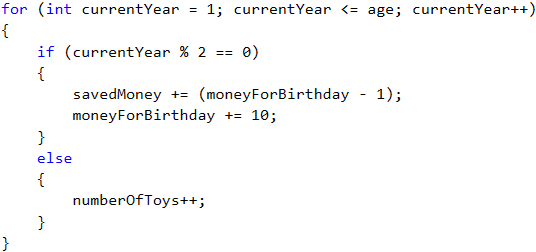Problem: Smart Lilly
Lilly is N years old. For each birthday she receives a present. For each odd birthday (1, 3, 5, …, n) she receives toys, and for each even birthday (2, 4, 6, …, n) she receives money. For her second birthday she received 10.00 USD, and the amount is increased by 10.00 USD for each following even birthday (2 -> 10, 4 -> 20, 6 -> 30 etc.). Over the years Lilly has secretly saved her money. Lilly's brother, in the years when she received money, took 1.00 USD from each of the amounts. Lilly has sold the toys, received over the years, each one for P USD and added the sum to the amount of saved money. With the money she wanted to buy a washing machine for X USD. Write a program that calculates how much money she has saved and if it is enough to buy a washing machine.
Input Data
We read from the console 3 numbers, each on a separate line:
- Lilly's age – integer in the range of [1 … 77].
- Price of the washing machine – number in the range of [1.00 … 10 000.00].
- Unit price of each toy – integer in the range of [0 … 40].
Output Data
Print on the console one single line:
- If Lilly's money is enough:
- “Yes! {N}” – where N is the remaining money after the purchase
- If the money is not enough:
- “No! {M}” – where M is the insufficiency amount
- Numbers N and M must be formatted up to the second digit after the decimal point.
Sample Input and Output
| Input | Output | Comments |
|---|---|---|
| 10 170.00 6 |
Yes! 5.00 | For the first birthday she gets a toy; 2nd -> 10 USD; 3rd -> toy; 4th -> 10 + 10 = 20 USD; 5th -> toy; 6th -> 20 + 10 = 30 USD; 7th -> toy; 8th -> 30 + 10 = 40 USD; 9th -> toy; 10th -> 40 + 10 = 50 USD. |
| 21 1570.98 3 |
No! 997.98 | She has saved 550 USD. She has sold 11 toys, 3 USD each = 33 USD. Her brother has taken for 10 years 1 USD each year = 10 USD. Remaining amount: 550 + 33 - 10 = 573 USD. |
Hints and Guidelines
The solution of this problem, like the previous one, can also be split into three parts – reading the input data, processing them and printing the output.
Reading the Input Data
We can read the input data like this:

We start again by selecting the appropriate data types and names of variables. For the Lilly's years (age) and the unit price of the toy (presentPrice) the description requires integers. That's why we will use int type. For the price of the washing machine (priceOfWashingMachine) we know that it is real number and we choose double. Of course, we can skip the explicit specification of type, by using var. In the above code we declare and initialize (assign value to) the variables.
Creating Helper Variables
To solve the problem, we will need several helper variables – for the count of toys (numberOfToys), for the saved money (savedMoney) and for the money received on each birthday (moneyForBirthday). The initial value of moneyForBirthday is 10, because the description says that the first sum, which Lilly gets, is 10 USD:

Calculating Savings

With a for loop we iterate through every Lilly's birthday. When the leading variable is an even number, that means that Lilly has received money and we add this money to her total savings. At the same time, we subtract 1 USD – the money that her brother took. Then we increase the value of the variable moneyForBirthday, i.e. we increase by 10 the sum that she will receive on her next birthday. On the contrary, when the leading variable is an odd number, we increase the count of toys. We do the parity check by division with remainder (%) by 2 – when the remainder is 0, the figure is even, and in case of remainder 1 – it is odd.
We also add the money from the sold toys to Lilly's savings.

Formatting and Printing the Output
Finally, we need to print the obtained results, considering the formatting specified in the description, i.e. sum needs to be rounded up to 2 symbols after the decimal point:

In this case we choose to use the conditional operator (?:) (also called ternary operator), because the record is shorter. Its syntax is as follows: operand1 ? operand2 : operand3. The first operand needs to be of bool type (i.e. to return true/false). If operand1 returns true, operand2 will be executed, and if it returns false – operand3 will be executed. In our case we check if the money saved by Lilly is enough for a washing machine. If it is more than or equal to the price of a washing machine, the check savedMoney >= priceOfWashingMachine will return true and will print “Yes! …”, and if it is less – the result will be false and “No! …” will be printed. Of course, instead of conditional operand, we can use if checks.
More about the conditional operator: https://www.dotnetperls.com/ternary, https://msdn.microsoft.com/en-us/library/ty67wk28.aspx.
Testing in the Judge System
Test your solution here: https://judge.softuni.org/Contests/Practice/Index/511#1.